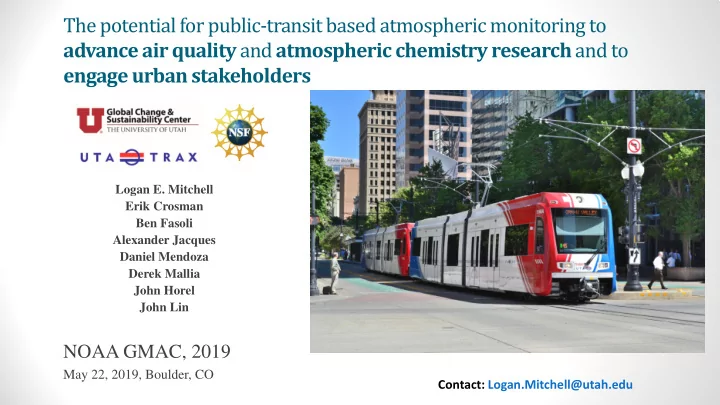

The potential for public-transit based atmospheric monitoring to advance air quality and atmospheric chemistry research and to engage urban stakeholders Logan E. Mitchell Erik Crosman Ben Fasoli Alexander Jacques Daniel Mendoza Derek Mallia John Horel John Lin NOAA GMAC, 2019 May 22, 2019, Boulder, CO Contact: Logan.Mitchell@utah.edu
The Big Picture… Policy Emissions Atmospheric Global composition Local Ambient • Sea level rise Climate air quality • Extreme weather Exposure/ • Ecosystem dose impacts • Human Human health health • Etc…
Simultaneous GHG & Air Quality Monitoring Salt Lake City’s GHG targets: • What monitoring networks & strategies are needed to understand emissions, chemistry, transport & trend detection? • How can we make research findings applicable to stakeholders & policy makers? • Progress towards emission reduction goals • Sector based emissions
• CO 2 , CH 4 , O 3 , PM 2.5 , NO 2 • Inlets 4m (~13’) above ground. • Post data in real time on the web: • http://utahaq.chpc.utah.edu/ • http://air.utah.edu https://doi.org/10.1016/j.atmosenv.2018.05.044
CO 2 Annual average CH 4 Annual average Brick factory Landfill Lower CO 2 on Natural gas urban periphery power plant Higher CO 2 along roads O 3 Seasonal average PM 2.5 Case studies Higher O 3 on urban periphery Titration of O 3 by NOx along the I-15 freeway. Typical patterns during inversions, thermal/terrain circulations, etc.
• CO 2 averages across different time ranges. • Seasonal • Day of week • Time of day • Illustrates the rich temporal structure of the data.
• Using TRAX data with STILT required updating the hyper-near field mixing parameterization. • Ongoing work to develop hyper local source apportionment using mobile observations & STILT.
Hot off the press: TRAX footprints & inversion uncertainty reduction.
Annual average Lower NO 2 on Hours: 0500-2400 urban periphery • NO 2 is a criteria pollutant w/ health • Ammonium nitrate (NH 4 NO 3 ) accounts for ~70% of the PM 2.5 mass during winter impacts. inversions along the Wasatch Front • NO x contributes to poor air quality in (Kuprov et al., 2014) summer & winter.
NO 2 Relationships • NO 2 and CO 2 are related through fossil fuel combustion. • Strong correlation (r = 0.83) • NO 2 and O 3 are related through atmospheric photochemistry. • Strong correlation (r = -0.96) • Illustrates the complex signature of fossil fuel combustion on urban atmospheric composition and air quality.
NO 2 Relationships • The excess NO 2 /CO 2 ratio (NO 2 /CO 2 above background conditions) provides insight into emission sources. • High ratios in the center of the valley occur where the is high NO 2 without a corresponding CO 2 signal • Warrants further investigation.
Proportional change in CO 2 and NO 2 does not affect the NO 2 /CO 2 ratio
• Large NO 2 plume centered on the Union Pacific locomotive rail yard. • ~3 ppb NO 2 increase from traffic on I-15. • NO 2 /CO 2 ratio is the fingerprint of different emission sources.
NO 2 Relationships ~3 ppb NO 2 • ~3 ppb NO 2 increase from traffic on I-15 increase by I-15 • Observed where TRAX crosses I-15 in three places.
Switcher Locomotives • Diesel locomotive “switcher” engines operate in rail yards to move rail cars around. • Operate 24/7 and often idle • Avoids difficult start-ups • Prevents engine blocks from freezing in the winter • ~60 switchers in Utah, 49 of which are • Utah Air Quality Board : Considers emission reduction policies up to operated by UPRR. $6,560/ton for area sources, and higher for large point sources. • Repowering switchers have a emissions reduction cost of $3,412/ton (Peter • 30% of UPRR’s switchers are Tier 0 and 70% are Verschoor, UDAQ, personal communication). Tier 0+. • (Glade Sowards, UDAQ, personal • States are prohibited from establishing emissions standards for locomotives in communication) the Clean Air Act, but they can offer incentives to encourage clean tech upgrades. • Replacing Tier 0+ with a Tier 4 switcher would reduce NO x emissions by 89%. • TRAX measurements could evaluate emission inventories and demonstrate air quality improvements after upgrades.
Take home points 1. Used public transit to observe spatiotemporal GHG and air pollutant patterns • CO 2 , CH 4 , O 3 , PM 2.5 , NO 2 2. Multi-species analysis: • Understanding atmospheric chemistry & transport • Identifying emission sources & evaluating inventories 3. Future directions: • Atmospheric modeling • Compare mobile, vs. stationary sites, vs. both • Evaluate emissions inventories. • Pollutants and health • Expansion • Understand atmospheric chemistry, including day vs • Improved spatial & temporal • Other cities night exposure maps • Low cost sensors • Measure more species (NOx, BC, etc.) • Spatiotemporal health impacts • Electric buses • Support field campaigns • Socioeconomic relationships • Google Street View mapping project! • Co-benefits of air quality and GHG mitigation policies Contact: Logan.Mitchell@utah.edu
Denver expansion on RTD • SLC & Denver have similar air quality challenges & GHG reduction goals. • Contact Isaac Vimont for more information
Two upcoming workshops: AQUARIUS (Air Quality Research in the Western US) Sept 25-26, 2019 in Salt Lake City, UT • Upcoming aircraft & ground field campaign • Wintertime PM formation chemistry, relationship to meteorology & co-emitted http://sites.bu.edu/co2usa/ GHGs in western basins.
Recommend
More recommend